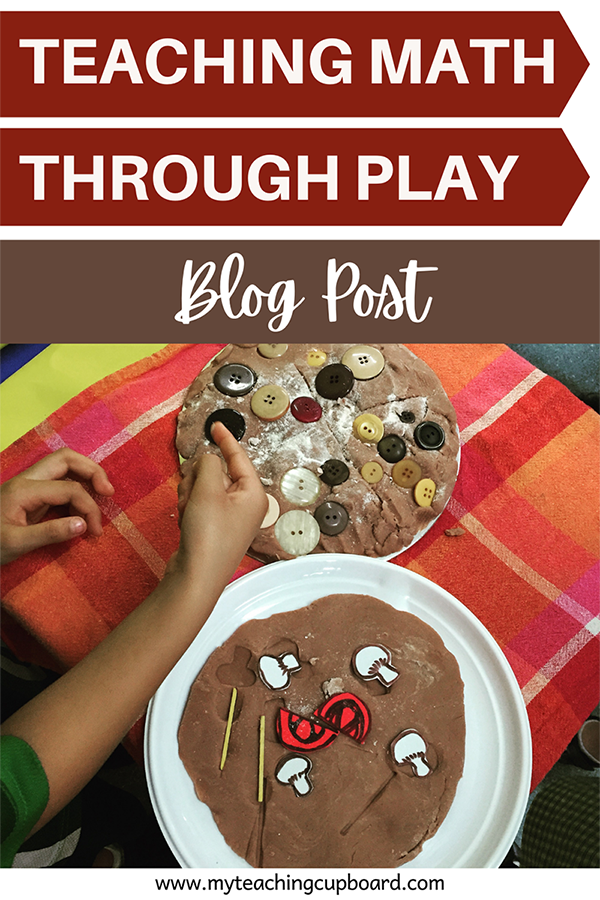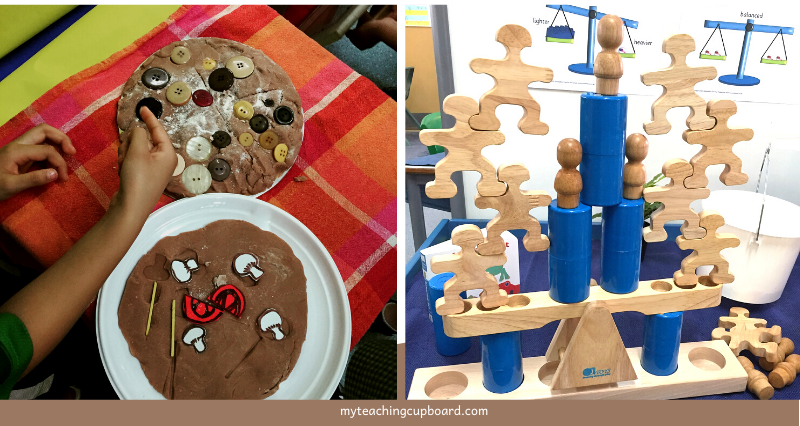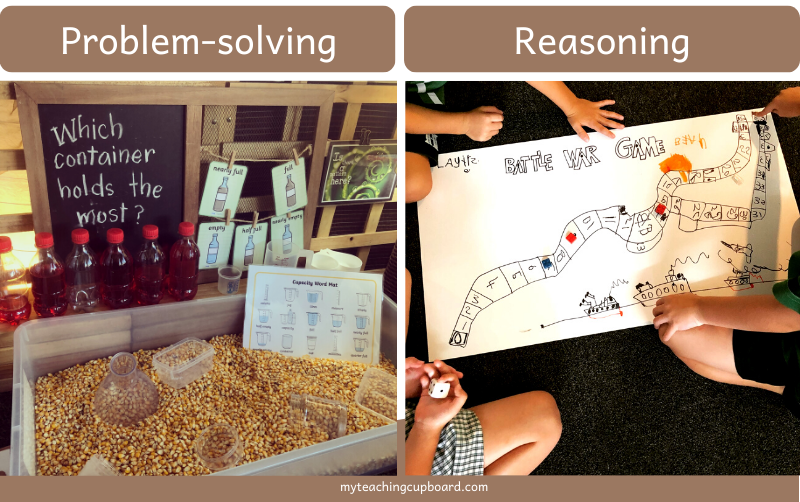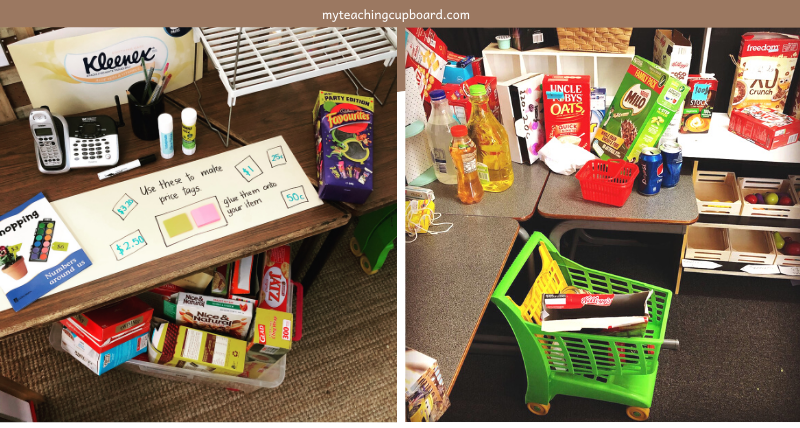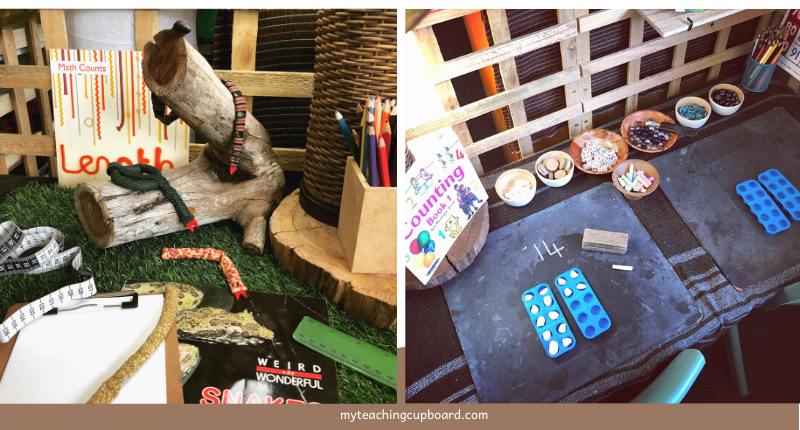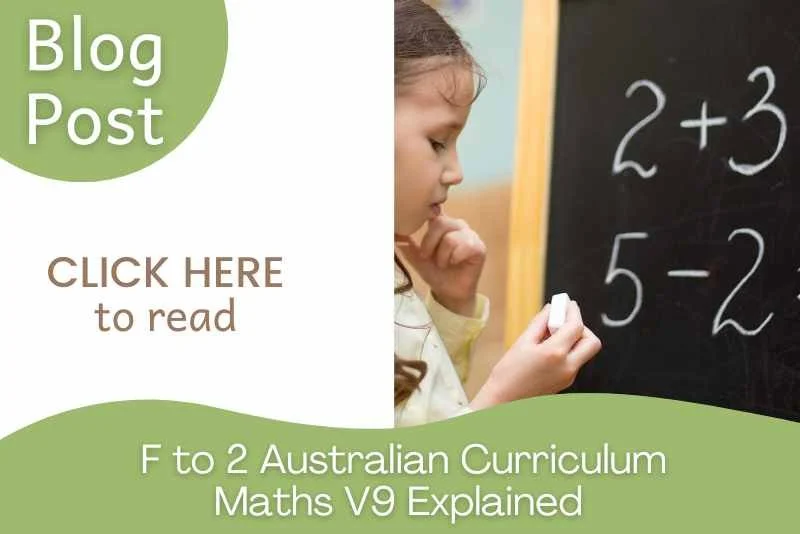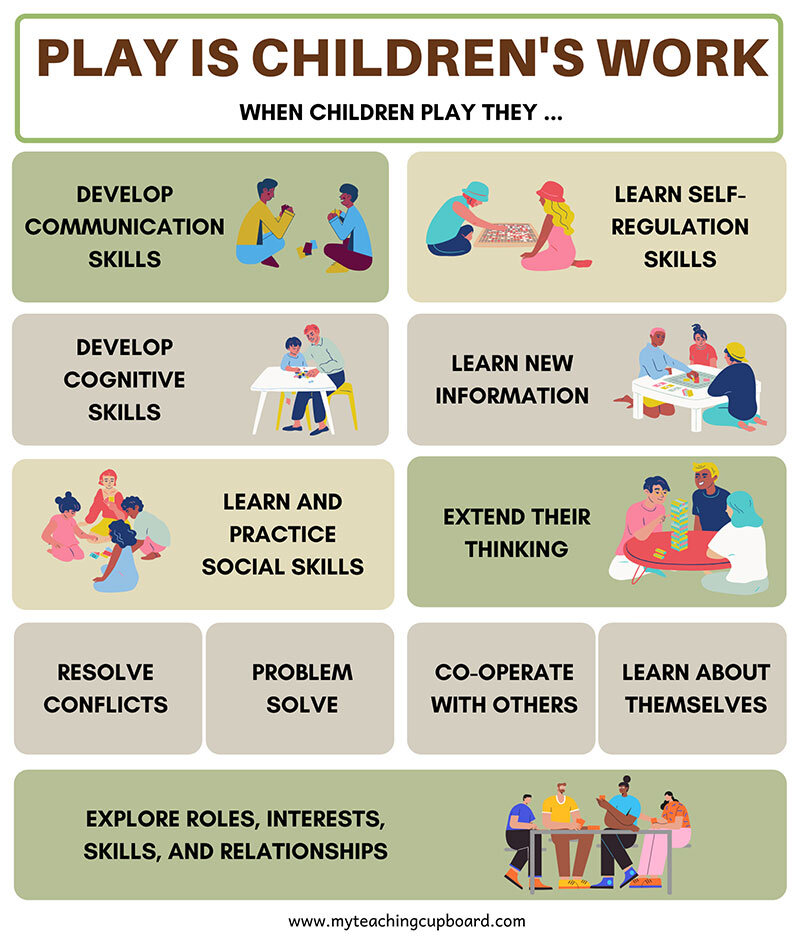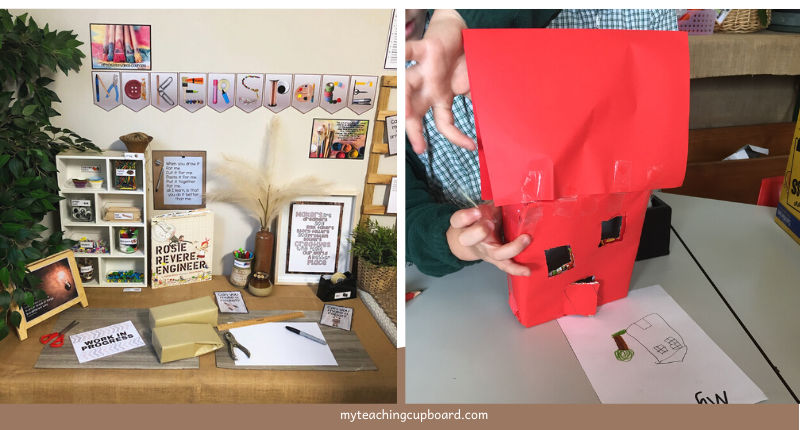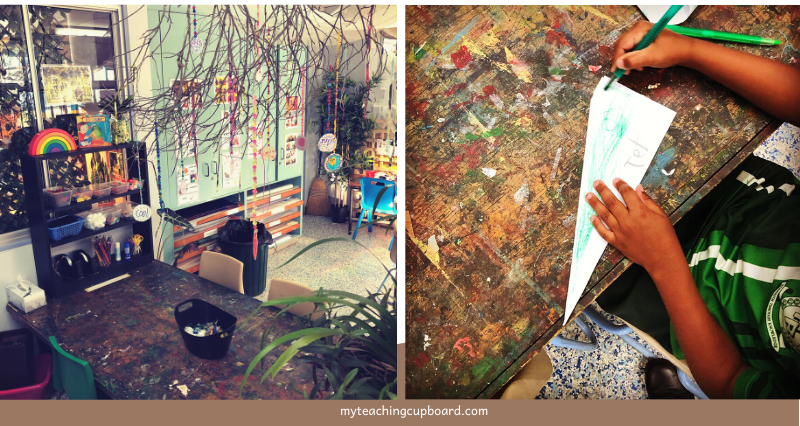Teaching the F-2 ACARA Math Learning Intentions Through Play
Discover how to teach ACARA Maths through play-based learning in Foundation to Year 2. This blog post shares hands-on strategies, activities, and resources aligned with Version 9 of the Australian Curriculum.
Our young children thrive when they can explore, investigate, and discover through play. After all, children really do learn best through play!!
But every play based teacher still needs to cover all the F–2 achievement standards in the Australian Curriculum: Mathematics (Version 9). And I have some good news.
Play-based learning is not just engaging and age-appropriate. It’s also one of the most effective ways to build strong mathematical foundations while still meeting all the ACARA V9 expectations.
As an early years teacher, you know early numeracy has nothing to do with rote memorization. It has everything to do with hands-on experiences, conversations, thinking, and problem solving.
Our goal in teaching maths is to create opportunities where our early years students are enjoying their math learning journey by using hands-on materials to build deep conceptual math understanding through play.
We are building the foundational math concepts and understandings children will base all their future math learning on, so we need to get it right. We need to focus on teaching mathematical concepts and strategies through age-appropriate math play.
With the updated Mathematics Version 9 (V9) of the Australian curriculum mathematics, the content descriptions are more refined and specific, particularly for foundational concepts such as counting, subitising, place value, patterns, and explicit teaching of early maths strategies. This makes it even more essential to find effective strategies that address these goals without compromising children’s natural curiosity and love for learning.
And perhaps most importantly, we need to provide real world hands-on opportunities of math experiences in a fun and playful way so we can effectively nurture our children’s love of maths.
In this blog post, we’ll explore the revised ACARA standards and explore how they align with play-based learning. There are practical ideas, strategies, and resources to make maths both meaningful and enjoyable AND that give your students the tools they need for a strong foundation in numeracy.
So let’s look a little closer at our F-2 ACARA Math Curriculum and discover ways we can teach ALL the updated Version 9 maths learning intentions through play.
The Australian Math Curriculum
The Australian Curriculum Website: Mathematics (Version 9) states there are five overarching aims. These five aims ensure that students:
Become confident, proficient, and effective users and communicators of mathematics, who can investigate, represent, and interpret situations in their personal and work lives, think critically, and make choices as active, engaged, numerate citizens.
Develop proficiency with mathematical concepts, skills, procedures, and processes, and use them to demonstrate mastery as they pose and solve problems and reason with number, algebra, measurement, space, statistics, and probability.
Make connections between areas of mathematics and apply mathematics to model situations in various fields and disciplines.
Foster a positive disposition towards mathematics, recognising it as an accessible and useful discipline to study.
Acquire specialist mathematical knowledge and skills that underpin numeracy development and open pathways to further study in mathematics and other disciplines.
Version 9 places an even stronger emphasis on using hands-on, developmentally appropriate experiences to build strong foundations in numeracy. This means that playful, practical activities in the early years are not just a good teaching strategy - they are now clearly supported by the curriculum itself.
ACARA builds on the key learning outcomes of the national Early Years Learning Framework. Both these guidelines acknowledge the power of play. They state play to be the most useful and most age-appropriate tool for literacy and numeracy learning.
The updated Version 9 curriculum in particular reinforces the importance of using developmentally appropriate, hands-on experiences to build foundational skills in numeracy.
After teaching in the F-2 grades for many years, I have noticed the way this age group learns best is not the same as for children in the upper grades. It is one of the reasons I support play-based learning in early childhood.
When we provide opportunities for children to investigate and learn through play, we are fostering authentic literacy and numeracy.
Teaching Numeracy
Understanding what numeracy is and what it should look like in our classrooms is the first step in teaching math through play-based learning.
‘Numeracy is the capacity, confidence and disposition to use mathematics in daily life. Children bring new mathematical understandings through engaging with problem solving. It is essential that the mathematical ideas with which young children interact are relevant and meaningful in the context of their current lives. Educators require a rich mathematical vocabulary to accurately describe and explain children’s mathematical ideas and to support numeracy development. Spatial sense, structure and pattern, number, measurement, data argumentation, connections and exploring the world mathematically are the powerful mathematical ideas children need to become numerate.’ (EYLF, 2009, p. 38)
ACARA V9 places an even greater emphasis on providing meaningful opportunities for children to connect their learning to real-world contexts. These experiences must be practical and hands-on, as outlined in content descriptions like AC9MFN05 and AC9MFN06, which focus on representing addition, subtraction, grouping, and sharing through physical and virtual materials.
So, if we are to teach math authentically and provide relevant and meaningful experiences, we must deliver a rich range of learning opportunities that provide experiences for children to be creative, to think, and to problem solve. And on top of that, these experiences must be ‘meaningful’ to the child.
It seems there is no better way to teach numeracy than through the rich range of learning opportunities we provide in our intentionally designed and purposeful investigation areas. Children exploring our play based investigation areas are consistently creating, thinking and problem solving.
The most significant strategies to promote early literacy and numeracy are in fact through play because it is clear that in the early years, children learn numeracy best through hands-on investigative play experiences.
So now let’s look at the content strands of the Australian curriculum because they describe the content we need to be teaching to our F-2 grades.
The Six Content Strands of ACARA
In Version 9 of the Australian Curriculum: Mathematics, content is now organised into six interrelated strands across each year level from Foundation to Year 10:
Number
Algebra
Measurement
Space
Statistics
Probability
Instead of listing proficiency separately, an expectation of mathematical proficiency is now embedded across all strands. This means students develop mastery in mathematics through an integrated focus on:
Understanding – knowing why as well as how
Fluency – using strategies flexibly and efficiently
Reasoning – justifying and explaining mathematical thinking
Problem solving – applying knowledge in familiar and new contexts
A Stronger, More Connected Curriculum
The six strands are designed to interconnect naturally:
Number and Algebra work together to describe relationships, patterns, and generalisations.
Statistics and Probability are closely linked, both relying on data, chance, and prediction.
Measurement and Space complement each other, while Measurement also underpins all other strands by giving students ways to quantify and compare.
Combined with Number, Measurement provides the means to communicate, evaluate, and make meaning of real-world situations.
This structure ensures teachers can focus on age-appropriate, impactful learning experiences while helping their students make meaningful links across different areas of mathematics.
Mathematical Processes in Action
The curriculum also highlights the importance of developing students’ skills in mathematical processes such as:
mathematical modelling
computational thinking
statistical investigation
probability experiments and simulations
When students are engaged in these processes through hands-on, play-based learning, they are not only covering the content but also strengthening their understanding, fluency, reasoning, and problem-solving skills in an integrated way.
The latest Version 9 has refined these strands by clearly defining the skills students need to master at each year level, starting with foundational concepts like subitising, quantifying collections, and recognising patterns. These updates ensure teachers can focus on the most age-appropriate and impactful learning experiences.
Number and Algebra
Although now presented as separate strands in Version 9, Number and Algebra remain deeply connected, as each enriches the study of the other. Students apply number sense and strategies for counting and representing numbers. They explore the magnitude and properties of numbers, apply a range of strategies for computation, and develop understanding of the connections between operations.
In the early years, students also begin to notice and describe patterns, building the foundations for algebraic thinking. They learn about variables and functions in very simple ways.
For example, by representing a missing value or continuing a repeating pattern. Over time, they build on their knowledge of the number system to describe relationships, formulate generalisations, and recognise equivalence in order to solve simple equations and inequalities.
So - What’s new in Version 9
ACARA Version 9 refines this area by focusing on foundational skills such as:
subitising collections
partitioning numbers in different ways
solving practical problems with both physical and digital materials
New descriptors include recognising patterns in various forms (AC9MFA01) and representing numbers to at least 20 in different contexts (AC9MFN01–02). These updates give teachers confidence that maths learning in F–2 starts with what is developmentally appropriate and hands-on.
Students should apply their number and algebra skills to conduct investigations, solve problems and communicate their reasoning using manipulatives, loose parts, and open-ended activities. This way, it keeps learning playful while still meeting the achievement standards.
I know it can feel overwhelming when you first look at all the math curriculum learning intentions for the Number and Algebra strand so I wrote a blog post to help you see that it doesn’t need to feel that way.
In my blog post you will discover 9 of my favourite play-based math activities for kindergarten number activities. You can check them out here: 9 Hands-on Maths Number Activities for Kindergarten
Measurement and Geometry
In Version 9 of the Australian Curriculum: Mathematics, Measurement and Space are presented as separate strands, but they still remain closely connected. Both help children make sense of the physical and constructed world around them.
Measurement is about quantifying aspects of the world, such as length, mass, capacity, and duration. Students learn to choose appropriate units and tools, and to compare and order objects and events.
Space develops children’s understanding of shape, position, direction, and movement. They visualise, represent, and describe 2D figures and 3D objects, exploring their properties and relationships.
Together, these strands provide students with essential ways to describe, compare, and interact with their environment.
What’s new in Version 9?
Version 9 makes these strands more concrete for teachers by explicitly connecting them to familiar contexts:
In Foundation, students sequence times of day using events such as morning and lunchtime (AC9MFM02) and describe the position of objects in relation to themselves (AC9MFSP02).
In Year 1, students measure length and capacity using informal units (AC9M1M01), and identify and sort shapes using obvious features (AC9M1SP01).
In Year 2, students compare and order lengths and capacities using uniform informal units (AC9M2M01), and classify shapes by describing their features with formal spatial language (AC9M2SP02).
This clear progression helps teachers see how measurement and spatial reasoning grow hand in hand from playful beginnings into more formal skills.
I like to present Measurement and Space (Geometry) together to emphasise their relationship to each other, enhancing their practical relevance. This way my students develop an increasingly sophisticated understanding of size, shape, relative position, and movement of two-dimensional figures in the plane and three-dimensional objects in space.
Through investigations in my classroom, they investigate properties and apply their understanding of them to define, compare, and construct figures and objects. They also learn to develop geometric arguments. Through hands-on play, they make meaningful measurements of quantities and build an understanding of the connections between units.
Because concepts like measurement can be abstract for young children, it helps to have a bank of engaging, hands-on activities ready to go. That’s exactly why I created my Measurement Provocations resource
It gives you low-prep, play-based ways to introduce length, mass, capacity, and time in line with ACARA Version 9.
Measurement isn’t the easiest math skill to teach that’s for sure! I have found for my young students to master measuring, they need to have pretty good fine motor skills and basic number sense concepts.
Preschool and kindergarten children learning to measure also need to learn a lot of new vocabulary along with new mathematical rules and procedures. That’s a lot for our little ones to grasp. No wonder measuring concepts can be difficult for some children.
But it really doesn’t have to be.
I’ve compiled a heap of practical and fun measurement activities that your kindergarten and preschool children will not only find success with but also love. You can check them out in this blog post: 9 Fun Hands-on Measurement Activities for Kindergarten
And if you have ever wondered…
How to teach kindergarten geometry in a fun and engaging way?
OR Why do we even need to teach geometry in preschool and kindergarten?
I have another blog post explaining why it is so important to teach kindergarten and preschool children geometry. There’s also some of my favourite Geometry activities and some teaching tips to help you in this blog post: Teaching Geometry in Kindergarten
Statistics and Probability
Version 9 places an increased emphasis on real-world data and early exposure to chance concepts:
In Year 1, students organise and display data using objects and drawings (AC9M1ST01) and use simple chance language to describe outcomes of familiar events (AC9M1P01).
In Year 2, students create simple picture graphs to represent data (AC9M2ST01) and describe the likelihood of events using everyday terms such as likely and unlikely (AC9M2P01).
This early introduction ensures students see maths as relevant and connected to their own experiences, whether tallying favourite fruits in class or predicting what might happen next in a game.
Both Statistics and Probability are easily introduced through playful, hands-on investigations. Here are just a few examples:
Conduct a class survey about favourite ice-cream flavours and build a picture graph with blocks.
Roll dice or spin spinners to explore chance, recording how often outcomes appear.
Use weather observations to talk about likelihood (“It’s cloudy - is it likely to rain today?”).
Statistics and Probability initially develop in parallel, and the curriculum then progressively builds the links between them.
The Australian Mathematics Curriculum is organised so that these six content strands (Number, Algebra, Measurement, Space, Statistics, and Probability) are intertwined and integrated with the key ideas and understandings of the four proficiency strands (understanding, fluency, reasoning, and problem solving).
This integrated approach has been adopted to ensure your students’ proficiency in mathematical skills develops throughout the curriculum and becomes increasingly sophisticated over their years of schooling. By weaving them together through play-based learning, you can build strong mathematical proficiency in ways that are engaging and developmentally appropriate.
The Key Ideas and Understandings of ACARA Maths
The key ideas and understandings of the ACARA Math Curriculum are closely integrated and should be taught in an integrated way. Play based investigations are ideal for integrating the content strands and the key ideas. They also address general capabilities and cross-curriculum priorities, showing how maths connects meaningfully across learning areas.
In Mathematics, the key ideas are the proficiency strands of understanding, fluency, problem-solving and reasoning. These strands describe the actions (or the “doing”) that students can engage in while learning and applying mathematical concepts.
ACARA V9 maintains the same proficiency strands but places a stronger emphasis on connecting these actions to real-world, hands-on learning opportunities. For example, content descriptions across Number and Algebra and Measurement explicitly call for activities where students explore, represent, and solve practical problems using physical and virtual tools.
Not all proficiency strands apply to every content description, but they reflect the breadth of mathematical actions that teachers can support through play based learning.
Understanding
Students build a robust knowledge of adaptable and transferable mathematical concepts. They make connections between related concepts and progressively apply the familiar to develop new ideas. They develop an understanding of the relationship between the ‘why’ and the ‘how’ of mathematics. Students build understanding when they
connect related ideas
represent concepts in different ways
identify commonalities and differences between aspects of content
describe their thinking mathematically
interpret mathematical information
In ACARA V9, understanding is further emphasised through activities that require students to use both physical and virtual materials to represent mathematical concepts. For example, Foundation students model addition, subtraction, and grouping scenarios using hands-on tools (AC9MFN05–06). This practical approach strengthens the connection between abstract ideas and their real-world applications.
In a play-based context, understanding develops naturally through hands-on exploration. For instance, children might use loose parts to create patterns or sort objects by attributes like “longer than” and “shorter than.” These activities make abstract mathematical ideas more tangible and meaningful, supporting conceptual growth.
Fluency
Students develop skills in choosing appropriate procedures; carrying out procedures flexibly, accurately, efficiently, and appropriately; and recalling factual knowledge and concepts readily. Students are fluent when they
calculate answers efficiently
recognise robust ways of answering questions
choose appropriate methods and approximations
recall definitions and regularly use facts
can manipulate expressions and equations to find solutions
In ACARA V9, fluency is highlighted as essential for building confidence in foundational skills like counting, subitising, and skip counting. For example, Foundation students practise fluency by subitising collections up to 5 (AC9MFN02), while Year 1 students develop fluency by skip counting by twos, fives, and tens (AC9M1N03).
Play-based learning supports fluency by embedding these skills into engaging, hands-on activities. For instance, children might practise skip counting while stacking blocks or calculate answers efficiently while sharing resources during role-play activities. This approach ensures fluency develops naturally in meaningful contexts
Problem-solving
Students develop the ability to make choices, interpret, formulate, model, and investigate problem situations, and communicate solutions effectively. Students formulate and solve problems when they
use mathematics to represent unfamiliar or meaningful situations
design investigations and plan their approaches
apply their existing strategies to seek solutions
verify that their answers are reasonable
In ACARA V9, problem-solving is reinforced through activities that encourage students to explore practical and real-world situations. For example, Foundation students represent addition and subtraction scenarios using physical materials (AC9MFN05), while Year 2 students solve problems involving equal sharing and grouping (AC9M2N05).
Play-based learning creates natural opportunities for problem-solving. Children might tackle challenges like building a bridge for toy cars in the makerspace or dividing a set of playdough balls equally among friends. These activities help them apply their existing knowledge to new contexts, fostering deeper mathematical understanding.
Reasoning
Students develop an increasingly sophisticated capacity for logical thought and actions, such as analysing, proving, evaluating, explaining, inferring, justifying, and generalising. Students are reasoning mathematically when they
explain their thinking
deduce and justify strategies used and conclusions reached
adapt the known to the unknown
transfer learning from one context to another
prove that something is true or false
compare and contrast related ideas and explain their choices
In ACARA V9, reasoning is emphasised through tasks that require students to justify their solutions and compare mathematical approaches. For instance, Year 1 students explain their reasoning when comparing the lengths of objects (AC9M1M01), and Year 2 students use reasoning to describe patterns and relationships in their data (AC9M2ST01).
Through play-based investigations, reasoning emerges naturally. Children might explain why one block tower is taller than another or justify their method for sorting objects into categories. These experiences not only develop logical thinking but also encourage students to articulate their ideas clearly, a vital skill in mathematics and beyond.
The key ideas and math understandings children develop through play-based investigations give them the tools they need to achieve a deeper understanding of mathematical concepts.
The 4 proficiency strands - understanding, fluency, problem-solving, and reasoning, are integral to maths learning across the six content strands: Number and Algebra, Measurement and Space/Geometry, and Statistics and Probability.
These proficiencies not only shape the way children engage with mathematical content and describe how the content can be explored or developed through play-based experiences, but also provide the language we need to use and teach in the mathematical conversations we have with our children.
The Australian Curriculum: Proficiency Descriptions by Year Level
The Australian Curriculum provides us with detailed descriptions of the proficiency strands for each level, from Foundation Stage to Grade 2.
These descriptions highlight the specific skills and understandings students are expected to develop, and they align closely with play-based learning approaches.
Foundation Year Level
Understanding includes connecting names, numerals, and quantities
Fluency includes readily counting numbers in sequences, continuing patterns, and comparing the lengths of objects
Problem-solving includes using materials to model authentic problems, sorting objects, using familiar counting sequences to solve unfamiliar problems, and discussing the reasonableness of the answer
Reasoning includes explaining comparisons of quantities, creating patterns, and explaining processes for indirect comparison of length.
In Version 9, Foundation students are also expected to represent practical situations involving addition, subtraction, and grouping using physical and virtual materials (AC9MFN05 and AC9MFN06). These updates reflect an emphasis on hands-on and real-world problem-solving at the earliest stages of learning.
Grade 1 Level
Understanding includes connecting names, numerals and quantities, and partitioning numbers in various ways
Fluency includes readily counting number in sequences forwards and backwards, locating numbers on a line and naming the days of the week
Problem-solving includes using materials to model authentic problems, giving and receiving directions to unfamiliar places, using familiar counting sequences to solve unfamiliar problems and discussing the reasonableness of the answer
Reasoning includes explaining direct and indirect comparisons of length using uniform informal units, justifying representations of data, and explaining patterns that have been created.
Version 9 expands fluency expectations to include skip counting by twos, fives, and tens (AC9M1N03) and introduces tasks requiring students to organise and represent data using drawings or physical objects (AC9M1ST01). These activities make reasoning and problem-solving more tangible for Year 1 learners.
Grade 2 Level
Understanding includes connecting number calculations with counting sequences, partitioning, and combining numbers flexibly and identifying and describing the relationship between addition and subtraction and between multiplication and division
Fluency includes readily counting numbers in sequences, using informal units iteratively to compare measurements, using the language of chance to describe outcomes of familiar chance events, and describing and comparing time durations
Problem-solving includes formulating problems from authentic situations, making models and using number sentences that represent problem situations, and matching transformations with their original shape
Reasoning includes using known facts to derive strategies for unfamiliar calculations, comparing and contrasting related models of operations and creating and interpreting simple representations of data.
In Version 9, Grade 2 includes more explicit expectations for creating picture graphs (AC9M2ST01) and using mathematical modelling to represent problems involving multiplication, division, and fractions (AC9M2N05 and AC9M2N06). These updates encourage deeper engagement with abstract concepts through practical applications.
Want to explore the F to 2 Maths Australian Curriculum further?
I have another blog post where you can discover how to teach the Australian Curriculum Maths F–2 with:
clear aims and learning objectives outlined
all six strands explained in simple language
and play-based strategies that save you prep!
By aligning these proficiency descriptions with play-based learning strategies, we can ensure our students not only meet curriculum goals, but also develop a genuine enthusiasm for maths. Playful exploration supports the development of these proficiencies by providing real-world contexts where students can think critically, experiment, and refine their understanding.
Making the Curriculum Accessible with Illustrated Math Learning Intentions
When you dive deep into the content of the F-2 ACARA Maths curriculum, there sure is a lot we must cover. The detailed content descriptions and proficiency strands in Version 9 make it clear that teachers need to address a wide range of skills, often simultaneously.
I have designed some illustrated learning intentions for Foundation Stage to make these expectations more manageable. This resource includes 162 visual WALT goals, covering all the key strands: Number and Algebra, Measurement and Geometry, and Statistics and Probability. Each learning intention is carefully aligned with ACARA Version 9 content descriptions.
Designing this maths resource made me painfully aware of how crammed our curriculum is. It’s not just the number of goals - it’s the need to communicate these goals effectively to young learners who may not yet be confident readers.
Why Use Illustrated Learning Intentions?
Use these illustrated learning intentions to help you explicitly teach the key understandings and math content for the Foundation level. I love these for the younger students.
Written learning intentions can be somewhat ineffective because little preppies are just not confident readers yet. When you refer to the written learning intention on display, all your little ones see is a collection of letters.
For this reason, I like to use illustrated learning intentions in my classroom. These learning intentions with the pictorial representations help students remember and understand their learning goals. The pictures act as a visual prompt, making the WALT goals accessible and meaningful for your students. This approach directly supports their ability to engage with the ACARA Version 9 objectives in a developmentally appropriate way.
There’s just not enough hours in the school day to effectively cover all those learning intentions – unless you implement a play based learning pedagogy.
Teaching Math Through Play Based Learning
A play-based pedagogy is grounded in experiences where children can explore, investigate, create, talk about, negotiate, discover, sort, count, measure, estimate, problem solve and think.
Open ended play-based learning experiences give children the chance to learn maths in a hands-on way. All teachers know there is no better way to teach math in the early years than through hands-on learning experiences.
Providing a range of maths activities in your classroom can support the development of:
Classifying and grouping skills.
Using a number line to solve problems.
Comparing and measuring objects through explicit teaching and exploration.
Building confidence with assessment tasks tied to hands-on experiences.
Play-based learning naturally keeps students on-task. A hands-on approach to learning where children are immersed in authentically rich experiences allows for creative exploration of foundational skills that promote numeracy.
The Box Construction Area or Makerspace is a great example of how children can experience a rich range of numeracy learning experiences through play.
Many math skills are developed in the process of working in this space. First of all, the child has to make the decision to go to this area to work and then decide what they can construct with the resources there. (problem solving) They need to negotiate and find a space at the table to work. (spatial awareness)
Then the child needs to make a series of mathematical decisions about their construction. For example, they may decide how to group similar materials, estimate quantities, or test different configurations for stability. She will estimate, sort, count and problem solve as she conceptualises the construction.
You might notice her measuring the size of the boxes, sorting shapes, estimating, or measuring out lengths of tape and string, experimenting with positioning and developing mathematical language.
Numeracy Skills Developed Through Play
Providing a range of play experiences in your classroom can promote numeracy skills like
Reasoning and Problem solving
Classifying, Grouping and Sorting
Patterning and Counting
Estimating and Measuring
Recognising, Distinguishing and Symbolising
Comparing and Contrasting
Representing their thinking mathematically
ACARA V9 further supports these skills by emphasising practical applications and hands-on modelling in content descriptions. For example, tasks like representing addition and subtraction with physical materials (AC9MFN05) or comparing lengths through direct experiences (AC9MFM01) naturally align with play-based learning approaches.
Play-based learning also supports the four proficiency strands:
Understanding develops as children represent concepts with hands-on materials, like arranging objects to show equal groups or quantities.
Fluency improves when children count sequences, recognise patterns, or estimate measurements in playful contexts.
Problem-Solving emerges naturally as children experiment, adjust their ideas, and test solutions.
Reasoning develops as children justify their methods, compare objects, or explain why something works.
The Role of the Teacher
As a facilitator, your role is to observe, ask open-ended questions, and gently guide children’s exploration. For example, asking, “What happens if you add another block to your tower?” encourages problem-solving and reasoning.
Multi-Sensory Learning
Play-based learning engages multiple senses, helping children retain concepts more effectively. By touching, manipulating, and moving materials, children gain a more concrete understanding of abstract mathematical ideas, supporting deeper learning.
Addressing Teacher Challenges
If you're worried about balancing play-based learning with meeting curriculum outcomes, remember that these hands-on experiences naturally address key maths skills outlined in ACARA V9.
For example, open-ended play allows students to explore concepts like subitising, addition, and measurement through meaningful and practical contexts, all while fulfilling the curriculum's requirements.
You might also feel overwhelmed by the "crammed" nature of the curriculum. The good news is that play-based pedagogy often integrates multiple strands and proficiencies at once.
A single activity - like building towers in the construction area, can support fluency in counting, reasoning about spatial arrangements, and problem-solving when something doesn’t go as planned.
The key is to trust in the process. Provide a variety of open-ended resources and observe how your students engage. You'll be amazed at the depth of learning that unfolds.
Student Autonomy and Engagement
Play-based learning not only addresses curriculum goals but also fosters autonomy and engagement in young learners. When children take ownership of their play, they are more likely to explore maths concepts deeply and independently, building a love for learning that lasts a lifetime.
For example, a child who decides to sort loose parts by size or shape isn't just practising classification. They're actively making decisions, testing ideas, and reflecting on their outcomes. This sense of ownership makes learning more meaningful and builds the critical thinking skills that will serve them well beyond the classroom.
Encourage your students to make choices, take risks, and collaborate with their peers during play. Autonomy in learning helps build confidence, resilience, and intrinsic motivation - all of which are essential for success in maths and other areas of their education.
Teaching math through playful learning experiences doesn’t need to be difficult. Play based learning is automatically differentiated, engaging and purposeful. Children will develop and learn math concepts and skills naturally through play.
All you need to do is provide open ended resources and the time and a space for your children to explore and investigate. Trust your children.
Math Resources for Play Based Learning
I have designed a number of hands-on play-based learning resources for teachers who want to support mathematics education through play. These include:
Foundation year statistics provocations for exploring data and chance concepts.
Investigation prompts, signs and posters for maths centres that support the current curriculum general capabilities.
Illustrated WALT goals aligned with the national curriculum, making it easy for students to visualise their goals.
By integrating play into the teaching of all the critical elements of maths, you’ll make a huge difference in how your students engage with the algebra strand, statistics, and shape and measurement content areas.
You will find a great selection to help you teach math sklls and concepts HERE.
Remember numeracy is supposed to be meaningful and a relevant part of everyday life for children in the F-2 grades. Our role is to not only teach maths but to build positive attitudes about numeracy.
Our children need and deserve the opportunity to learn through playful experiences that support and promote numeracy and all other aspects of their learning and development. By incorporating play-based learning strategies, you can meet curriculum goals, foster deep understanding, and nurture a lifelong love of learning in your students.
Please don’t rely on formal and structured numeracy lessons alone. Trust in the power of play to make maths accessible, engaging, and fun for your students.
Set up some play-based learning areas in your classroom and make the implementation of the Australian curriculum purposeful and relatable!
👉 You’ll find my full range of Australian Curriculum-aligned Maths resources useful. They are all designed to save you prep time, meet ACARA goals, and keep your maths engaging and hands-on!
If you found this blog post on teaching the F-2 ACARA Math learning intentions through play helpful or interesting, please consider sharing it. You’ll be helping other teachers discover effective strategies for their classrooms.
Just CLICK the sharing box below.👇

